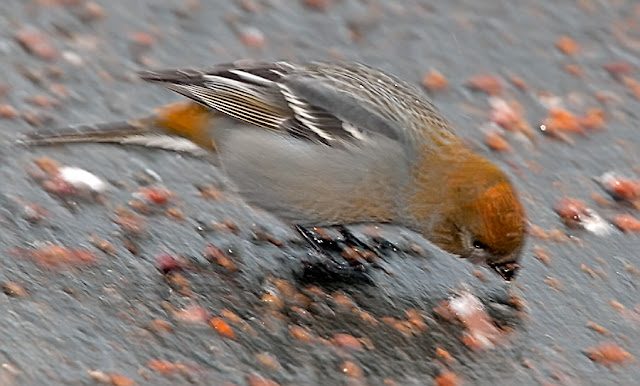My first view of the great eastern boreal forest was from 33,000 ft up traveling home from a visit with my family in Germany. Down below lay a dark green expanse interrupted only by the distant glitter from bogs, lakes and and snaking rivers. Far and wide in between straight roads as if laid down with a ruler were the only signs of human presence. This is still the home of billions of birds who are moving south only when their food supplies are running low. Every year winter finch forecasts are being published based on the seed crop supply. Click here to see this year's forecast.
A couple of weeks ago when out with my dog I saw three plump birds with taupe undersides, two white wingbars and rusty caps feeding on a crab apple tree. At first I didn't recognize them but then "rusty" clicked in my head: female Pine Grosbeaks! In Dec 2007 I had photographed a flock in a road-side crab apple tree. The majority were females but I was lucky to also see a male as males often stay behind.
Since then I have seen many reports of sightings on the Mass, NH and VT state birding listservs. So it's starting to look like a true irruption.
Just the other day a large flock of about 30 birds appeared in Turner's Falls in the crab apple trees along an urban sidewalk gorging themselves on the fruit. They were all females, or immature males, with no adult males in sight. A light snow was falling. I took many photos but ended up deleting most of them since the birds in the trees were just dark gray shadows against a brilliant white sky. But many were feeding on the sidewalk and allowed me to come very close.
Drinking from a puddle
The Evening Grosbeak, nominated as the 2012 ABA Bird of the Year, is at home in the coniferous and mixed forest of western northern US and Canada. With their massive bills they are masters at cracking nuts and seeds. They used to be common visitors at winter feeding stations in the East but in the last decades their numbers have plummeted. See Laura Erickson's ABA blog post on "What is happening to Evening Grosbeaks?".
I first saw the bird just after I had moved from Kansas to Western Mass in 1980. I was renting a condo with a balcony looking out on a patch of swamp and coniferous forest. I had put our sunflower seeds in a tray on a table for flock of House Finches and one snowy morning I vividly remember a flock of large yellow, white and black birds swirling around the balcony with a great deal of commotion and loud noise and making short work of the seeds. Fascinated I kept refilling the tray.
Since then I have seen them only on rare occasions. With their imposing presence, their bold colors and massive beaks, they always strike me as being somehow larger than life.
Crossbills are true boreal nomads. They are totally dependent on the seeds in spruce and pine cones, and appear wherever their food supply is plentiful. Their oddly shaped bill allows them to pry open the scales of cones to extract the seeds. Rarely do they show up at backyard feeders.
Immature White-winged Crossbill at feeder
Recently I drove to Salisbury Beach State Park to see the Crossbills reported there. The pine trees there were bursting with cones. Chattering flocks of Crossbills were lofting up, then settling down again on a different group of trees. White-winged Crossbills were in the majority but I also saw several Red Crossbills.
Adult male White-winged Crossbills look rosy as if dipped in red wine whereas immature males are peach-colored.
Females are unobtrusively gray and olive, and have, like the males, white wing bars
Red Crossbills come in various shades of brick red with white undertail coverts. They lack wing bars. There appear to exist at least 10 types distinguishable only by their call and size of bill.
The Purple Finch is a moderately common winter visitor in the lower US. Its natural foods are coniferous and deciduous hardwood seeds. When these are in short supply it turns up in larger numbers at feeding stations.
A note about finches: Several years ago I found a small flock of dead House Finches scattered on the dirt road in front of my house. They seemed to have been hit by a car but how and why? I found the answer in Ron Pittaway's Winter Finch Basics:
"Road Kills: Thousands of finches are killed by cars in some winters when they seek the salt and sand put on roads. They have no fear of cars. If you see finches on the road, slow down, flash the lights and tap the horn. Be careful not to confuse other drivers."
The Snowy Owl lives and breeds the Arctic tundra but is an occasional winter visitor in the contiguous US. Last year we had an unprecedented Snowy Owl invasion. A much larger number of young owls than usual had fledged and outgrown the local food supply. The young owls had to migrate south or starve. They showed up as far south as Texas. Many probably did not survive and few, if any, made it back to the Arctic.
One morning a young (you can tell as mature owls are almost completely white) Snowy Owl showed up at a local cornfield. It sat immobile for much of the day, only occasionally turning its head. Later on it flew briefly up into a tree and at dusk settled on a partially submerged tree in the West River. Eventually it left to parts unknown.
PBS recently showed a mesmerizing video on Snowy Owls on their Nature program. Here is link to the full-length video.
Happy Winter Birding and Happy Holidays!






















































